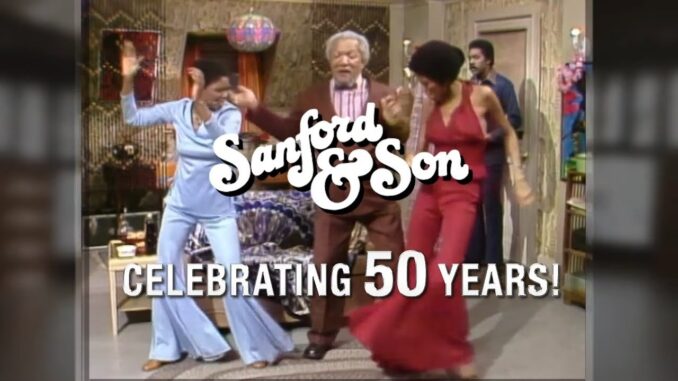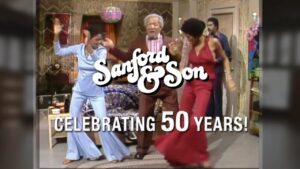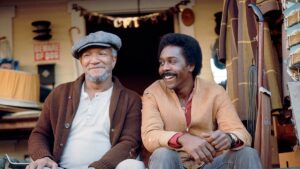
The 50th Anniversary of Sanford and Son (p1)

It was 50 years ago today, on January 14 1972, that the sitcom Sanford and Son debuted on NBC. Sanford and Son centred on junk dealer Fred G. Sanford (Redd Foxx) and his son Lamont (Demond Wilson). Fred was a bit lazy, sarcastic, and prone to get rich schemes. As to Lamont, he simply wanted to expand his horizons beyond his father’s junkyard. The conflict between the two fuelled the plots of many of the show’s episodes throughout the show’s run. Sanford and Son proved to be a hit upon its debut and ranked no. 6 for the year in the Nielsens during its first season. Ultimately Sanford and Son remained in the top ten shows each year for five of its six seasons.
Sanford and Son was based on the hit British sitcom Steptoe and Son. Debuting in 1962 on BBC 1, Steptoe and Son was phenomenally successful in the Untied Kingdom. At its height, up to 25 million viewers (around half the population of Britain) tuned into Steptoe and Son. Such success did not go unnoticed in the United States, so that movie producer Joseph E. Levine bought the rights to do an American version of the show. Produced in 1965, the pilot featured Lee Tracy as Albert Steptoe and Aldo Ray as his son Harold. The pilot failed to sell and never aired in the United States. One further attempt at another American pilot got no further than the planning stages.
Joseph E. Levine retained the rights to an American version of Steptoe and Son until 1971. Once Mr. Levine’s rights had lapsed, Norman Lear and Bud Yorkin bought the rights to do an American version of the show. At the time Mr. Lear was fresh from his success with All in the Family, itself an adaptation of the hit British sitcom Till Death Do Us Part. With Norman Lear preoccupied with All in the Family, Bud Yorkin brought Aaron Ruben, a veteran of such sitcoms as The Phil Silvers Show and The Andy Griffith Show, onto the project. A pilot was shot with Bernard Hughes as an Irish American junk dealer and Paul Sorvino as his son who favoured his mother’s Italian side. This pilot never made it to series.
It was then decided that their junk dealer and son in their American version of Steptoe and Son should be Black. Messrs. Yorkin and Ruben approached Cleavon Little about doing the pilot, but he declined due to other commitments. While Mr. Little was unable to do the pilot, he did suggest to them comedian Redd Foxx. Redd Foxx had appeared in the movie Cotton Comes to Harlem (1970) with Cleavon Little. He played the character of junk dealer Uncle Budd. Redd Foxx was a comedian with a successful nightclub act and was even one of the first Black comedians to play the Las Vegas Strip.

Redd Foxx would have an enormous impact on shaping Sanford and Son. He even gave the show its name. Redd Foxx was born James Elroy Sanford. His older brother, Fred Sanford, Jr. provided his character’s first name. While the majority of first season episodes were based directly on Steptoe and Son scripts, it differed from the British sitcom in that Redd Foxx brought a strong dose of Black comedy to Sanford and Son. Race was never too far from the forefront on Sanford and Son. For the role of Fred’s son Lamont, Demond Wilson was cast. Mr. Wilson had played a burglar in the All in the Family episode “”Edith Writes a Song.”
Rehearsals for the pilot began in August 1971 at CBS’s Fairfax Studio. Given All in the Family had been a success for CBS, Norman Lear and Bud Yorkin tried to interest that network’s executives in attending rehearsals, but none of them did. Bud Yorkin then contacted his old friend Herb Schlosser, then NBC’s vice president in charge of West Coast programming. Curiously, Mr. Schlosser had made the deal to get the rights to Steptoe and Son for the earlier pilot produced by Joseph E. Levine and starring Lee Tracy and Aldo Ray. Being familiar with both Steptoe and Son and Redd Foxx’s comedy, Herb Schlosser was immediately interested. He then arranged for Mort Werner, NBC’s senior vice president for programming, to attend the taping of the pilot. Messrs. Schosser and Werner then had to venture onto their archrival network’s territory, the pilot being shot at CBS. In the end NBC committed to picking up 17 episodes of Sanford and Son, set to start in January 1972.
Sanford and Son debuted on January 14 1972 to generally positive reviews. Joan Crosby in the “TV Scout” syndicated newspaper column wrote of the show, “Good news: Sanford and Son is a funny program.” Joyce Haber, columnist for The Los Angeles Times, wrote, “And if my opinion means anything, it’s warm but stingingly hilarious, sharply written (by Aaron Ruben) and timed show which deserves the top honour.” The New York Daily News named Sanford and Son, “…a warm, funny show.” This is not to say that some did not have a negative view of the show, especially in the Black community. Walter Burrell, columnist for Soul magazine, was particularly critical of how Lamont treated Fred in the early episodes, writing, “To say the younger man was disrespectful would be an understatement.” As late as June 17 1973, after which the show had seen considerable success, Eugenia Collier wrote in The New York Times, “For in spite of Redd Foxx’s jokes and Demond Wilson’s black beauty, Sanford and Son remains white to the core.”
Audiences obviously agreed with the majority of positive reviews rather than the minority of negative ones. For the week ending January 16 1972, the premiere of Sanford and Son came in at no. 5 in the Nielsen ratings. Over the following weeks it continued to be successful, ultimately ranking no. 6 for the 1971-1972 season. It would be even more successful in its second season, ranking no. 2 for the year, right behind All in the Family.
While Sanford and Son was a hit from the beginning, it would take some time for it to become the show that most of us remember. In the first season Lamont could be rather hard on his father, and could even be perceived as disrespectful at times. Lamont even referred to Fred’s girlfriend Donna Harris (Lynn Hamilton) as “the barracuda” and would even go so far as to try to sabotage Fred and Donna’s relationship. Among the critics of Lamont’s attitude towards his father were no less than Redd Foxx and Desmond Wilson themselves. Fortunately Aaron Ruben softened Lamount’s attitude towards Fred and their relationship became a warmer, more loving one. Lamont’s attitude towards Donna was even changed, to where he was even friendly towards her. In the end, Lamont became a character who, while at times annoyed by his father’s behaviour, was still devoted to him.
Another way in which the first season of Sanford and Son differed from the show most of us remember is that many of its most memorable characters were not yet on the show. The first season would see the introduction of only three of the show’s best known characters. The first was Officer “Smitty” Smith (Hal Williams), a Black police officer whose beat includes Fred’s neighbourhood. Smitty’s original partner on the show was Officer “Swanny” Swanhauser (Noam Pitlik), who would speak in police jargon that Smitty would have to translate for Fred. He was replaced early in the second season by Officer Howard “Hoppy” Hopkins, who would not only speak in police jargon, but would always get slang terms wrong (for instance, “right up” instead of “right on”). Also appearing in the first season was Fred’s girlfriend Donna Harris, a practical nurse who tended to be so sweet natured that she was even able to tolerate Fred’s antics for the most part.
….
